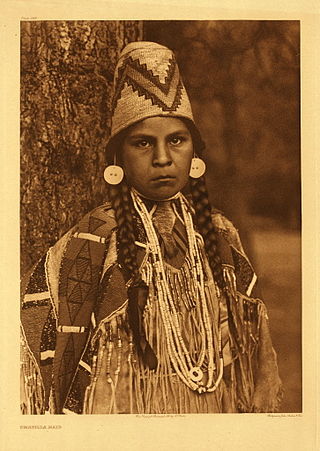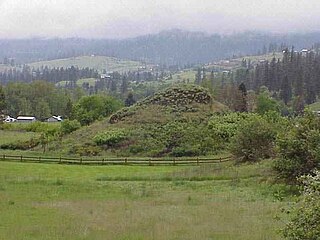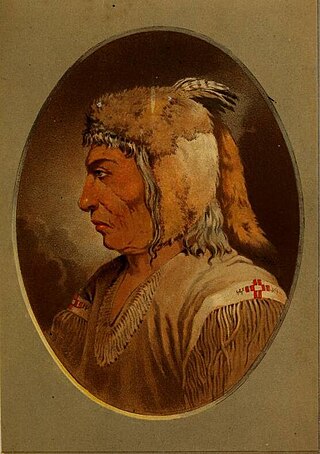
The Nez Perce are an Indigenous people of the Plateau who still live on a fraction of the lands on the southeastern Columbia River Plateau in the Pacific Northwest. This region has been occupied for at least 11,500 years.

The Yakama are a Native American tribe with nearly 10,851 members, based primarily in eastern Washington state.

Chinookan peoples include several groups of Indigenous people of the Pacific Northwest in the United States who speak the Chinookan languages. Since at least 4000 BCE Chinookan peoples have resided along the upper and Middle Columbia River (Wimahl) from the river's gorge downstream (west) to the river's mouth, and along adjacent portions of the coasts, from Tillamook Head of present-day Oregon in the south, north to Willapa Bay in southwest Washington. In 1805 the Lewis and Clark Expedition encountered the Chinook Tribe on the lower Columbia.

The Warm Springs Indian Reservation consists of 1,019 square miles (2,640 km2) in north-central Oregon, in the United States, and is governed by the Confederated Tribes of Warm Springs.

The Dalles Lock and Dam is a concrete-gravity run-of-the-river dam spanning the Columbia River, two miles (3.2 km) east of the city of The Dalles, Oregon, United States. It joins Wasco County, Oregon, with Klickitat County, Washington, 192 miles (309 km) upriver from the mouth of the Columbia near Astoria, Oregon. The closest towns on the Washington side are Dallesport and Wishram.

The Chinookan languages are a small family of extinct languages spoken in Oregon and Washington along the Columbia River by Chinook peoples. Although the last known native speaker of any Chinookan language died in 2012, the 2009-2013 American Community Survey found 270 self-identified speakers of Upper Chinook.

The Umatilla are a Sahaptin-speaking Native American tribe who traditionally inhabited the Columbia Plateau region of the northwestern United States, along the Umatilla and Columbia rivers.

The Confederated Tribes of the Umatilla Indian Reservation are the federally recognized confederations of three Sahaptin-speaking Native American tribes who traditionally inhabited the Columbia River Plateau region: the Cayuse, Umatilla, and Walla Walla.

Celilo Falls was a tribal fishing area on the Columbia River, just east of the Cascade Mountains, on what is today the border between the U.S. states of Oregon and Washington. The name refers to a series of cascades and waterfalls on the river, as well as to the native settlements and trading villages that existed there in various configurations for 15,000 years. Celilo was the oldest continuously inhabited community on the North American continent until 1957, when the falls and nearby settlements were submerged by the construction of The Dalles Dam. In 2019, there were calls by tribal leaders to restore the falls.

Celilo Village, Oregon is an unincorporated Native American community on the Columbia River in northeastern Wasco County in the U.S. state of Oregon. It is near Lake Celilo, the former site of Celilo Falls; it is just south of the community of Wishram, Washington, across the Columbia River.

Indigenous peoples of the Northwest Plateau, also referred to by the phrase Indigenous peoples of the Plateau, and historically called the Plateau Indians are Indigenous peoples of the Interior of British Columbia, Canada, and the non-coastal regions of the Northwestern United States.
Kathlamet (Cathlamet) was a Chinookan language that was spoken around the border of the U.S. states of Washington and Oregon by the Kathlamet people. The most extensive records of the language were made by Franz Boas, and a grammar was documented in the dissertation of Dell Hymes. It became extinct in the 1930s and there is little text left of it.

The Confederated Tribes of Warm Springs is a federally recognized Native American tribe made of three tribes who put together a confederation. They live on and govern the Warm Springs Indian Reservation in the U.S. state of Oregon.
Upper Chinook, endonym Kiksht, also known as Columbia Chinook, and Wasco-Wishram after its last surviving dialect, is a recently extinct language of the US Pacific Northwest. It had 69 speakers in 1990, of whom 7 were monolingual: five Wasco and two Wishram. In 2001, there were five remaining speakers of Wasco.

The Tenino people, commonly known today as the Warm Springs bands, are several Sahaptin Native American subtribes which historically occupied territory located in the North-Central portion of the American state of Oregon. The Tenino people included four localized subtribes — the Tygh or "Upper Deschutes" divided in Tayxɫáma, Tiɫxniɫáma and Mliɫáma, the Wyam (Wayámɫáma) (Wayámpam) or "Lower Deschutes", also known as "Celilo Indians", the Dalles Tenino or "Tinainu (Tinaynuɫáma)", also known as "Tenino proper"; and the Dock-Spus (Tukspush) (Takspasɫáma) or "John Day."

Wishram Village, referred to as nixlúidix by its residents, was a summer and winter village on the Columbia River, Washington, United States occupied by Upper Chinook people. It is considered the largest prehistoric Chinook village site. The site is now part of Columbia Hills State Park.
Billy Chinook was a chief and member of the Wasco tribe. Chinook was a guide for John C. Frémont and Kit Carson, who explored Central Oregon from 1843 to 1844 and from 1845 to 1847. Chinook also served as First Sergeant, U.S. Army Wasco Scouts during the Snake War. Lake Billy Chinook in Oregon is named in his honor.
The Celilo Fish Committee is a committee formed by representatives from the Yakama Nation of Washington.
The Columbia River Inter-Tribal Fish Commission (CRITFC) is a fishery resource for the treaty tribes of the Columbia River. Under the treaty, the native tribes, The Nez Perce Tribe, Warm Springs Reservation Tribe, and Umatilla Indian Reservation Tribe, have to the right to fish in the Columbia River, which means their fishery must be reserve and protect.

The Skinpah were a Sahaptin-speaking people of the Tenino dialect living along the northern bank of the Columbia River in what is now south-central Washington. They were first recorded as the E-nee-shers in 1805 by Lewis and Clark. Their village, Sk'in, was located adjacent to Celilo Falls in modern day Klickitat County.
















